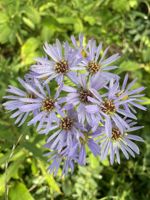Mon-Fri 9am - 5pm Mountain time
Showy Aster vs Blue Flax
Eurybia conspicua
Linum lewisii
CUSTOM GROW
NOT AVAILABLE THIS SEASON - MIGHT RETURN
Showy Aster is a native perennial wildflower recognized for its tall stems topped with clusters of light purple blooms. Blooming from late summer into autumn, it provides an important late-season source of nectar and pollen for pollinators. It also produces seeds that are eaten by birds, extending its value to wildlife beyond the flowering season.
Drought tolerant once established, Showy Aster grows well in urban, rural, and disturbed sites. With its mix of ecological value and ornamental appeal, it is ideal for pollinator gardens, naturalization projects, and ecological restoration.
Blue Flax is a native perennial wildflower known for its blue to violet flowers. Each flower lasts just a single day, but new blooms appear continuously, providing weeks of colour. This extended flowering period provides a reliable display from late spring into summer and attracts a variety of pollinators.
They can self-seed readily, so removing spent blooms helps manage their spread. Birds feed on the seeds, and when cooked, they are edible and are described as having a mild, nutty flavour. The plant grows in loose clumps with slender stems and fine foliage. Young plants are leafy, but as they mature, most leaves are shed.
Blue Flax grows well in a wide range of soils, including poor or sandy conditions, and is drought-tolerant once established. The deep root system helps to stabilize soil and prevent erosion. They are well-suited for pollinator gardens, restoration, naturalization, and xeriscaping projects.
Showy Aster Quick Facts
Blue Flax Quick Facts
Toxicity: toxic to some animals, raw seed toxic

